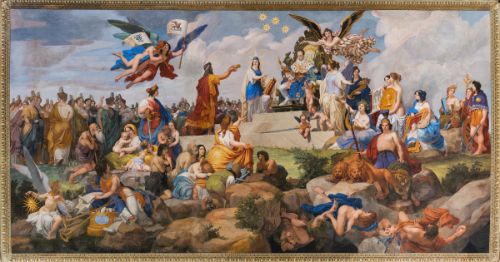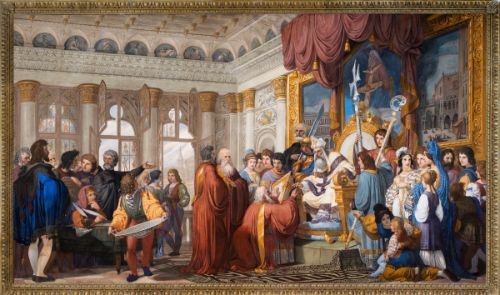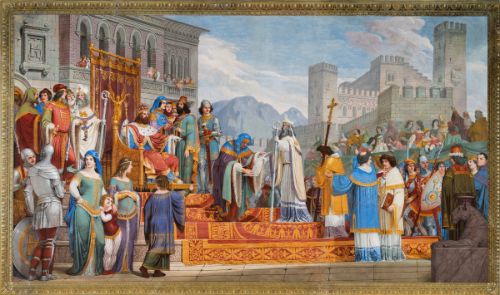The Civic Hall
Situated on the main floor and formerly known as the Hall of Victory in the original museum layout, this was the place where the Great Council of the Community of Ceneda gathered.
Under Austrian rule between 1842 and 1844, it was completely painted with historical scenes, works by the Belluno-born painter Giovanni De Min, and Paolo Pajetta (father of the famous Peter) for the ornamental pieces.
The themes of the hall were described for the first time in 1848 by Jacopo Bernardi, a writer from Ceneda who wrote L'aula Civica del Cenedesi con li suoi affreschi [The Civic Hall of Ceneda with its frescoes] in which he narrates both the themes of the frescoes and the history of the bishops of Ceneda. An anastatic copy of the book was reprinted in 2014 and is in distribution.
Ceiling - Coronation of S.M.I.R.A. [His Imperial and Royal Apostolic Majesty] Ferdinand I King of Italy
The coronation of Emperor Ferdinand of Habsburg as King of Italy is extravagantly illustrated on the ceiling, recaptured completely by the painter De Min from the "Glory of Ferdinand I of Habsburg," a contemporary fresco that his friend Francesco Hayez had painted in Milan for the Royal Room. The theme is treated in the same way, with some variations of a compositional and colouristic nature.
At the centre of the composition, Ferdinand I of Habsburg is seated on a throne. He is crowned by the Spirit of Austria, the winged figure wrapped in a drape with white and red strips, the colours of Austria. Four stars hover over the head of the sovereign containing the initials of the most prominent emperors: Maria Theresa, Franz Joseph, Rudolph I and Wilhelm II. To the right of Ferdinand is Religion, perfectly centred in the painting and recalling traditional portraits of the Virgin Mary.
To his left, Peace and the little spirits of the Arts, Industry and Commerce are standing, playing with olive wreaths taken from the bundle held by Peace. Seated by her feet is Poetry with Architecture, Sculpture and Painting behind her, recognised by their attributes. To the right Science, Agriculture, Industry (holding a stick with one hand on top) and Commerce (dressed as a pilgrim with a wheel and anchor indicating the routes by land and sea) are depicted. Strength is in front of them, a tough boy with two ferocious lions keeping three evil spirits at bay underneath them, who are falling into the underworld.
The Emperor is crowned by Law and behind him the two spirits of Lombardy and Veneto (recognised by their banners with their respective emblems: the Visconti snake and the Lion of St Mark) share an embrace.
Below is Justice protecting the poor and needy – the elderly, women and children. In front of her is Mercy who is hiding shameful offenders from the Emperor, saved by his grace promulgated in 1848, when he was crowned King of Lombardy and Veneto. History is below Justice, writing the annals of the eighteenth and nineteenth centuries, and Truth with the sun and mirror is nearby. Behind, are the crowds from the cities of Lombardy and Veneto going to pay homage to their new king.
There are two monochrome paintings at the sides of the central fresco, depicting the mercy of Ferdinand (there is an amnesty in the year of his appointment, hence the reminder, with Mercy releasing criminals from prison and Merit crowning the illustrious citizens), and the spirits of Veneto and Lombardy crowning the worthy citizens.
North wing - Defeat of Guecellone da Camino by the Captain of the Bishop of Ceneda, 8 June 1317
The big battle scene tells of the defeat of the Camino family, Lords of Feltre and Serravalle, who had attempted to besiege the Castle of San Martino, residence of the then Bishop of Ceneda, Manfredo di Collalto, son of Raimbaut VIII Count of Collalto. On 8 June 1317, the Camino army arrived at the walls of the fortress at dawn, but failed to conquer it and so the captain of the Bishop's army, possibly Adalgerio della Torre defeated them, but there are no documents confirming this. The scene illustrates the moment of escape and retreat by Guecelone da Camino, with the insignias of the Camino above (a part white part black shield). The dynamics of the scene are very interesting, with many detailed events that become almost isolated scenes of suffering, with men and women defeated and slain.
The background shows the Castle of San Martino, the Fortress (now in San Paolo al Monte) and the fortification of St Eliseo (now St Rocco).
West wall - Francesco Ramponi hands over the Camino fiefs to the Prosecutors of San Marco - 12-X-1337
The episode painted here portrays the death of Rizzardo VI, the last surviving member of the da Camino di Sopra family. He died in 1335 leaving his widow Verde della Scala with three daughters, hence interrupting the line of succession. Verde della Scala therefore returned the ancient fief of Serravalle to the Bishop of Ceneda.
At that time, the Bishop of Ceneda was Francesco Ramponi, a Bologna-born scholar, who decided to return the fief of Serravalle to the Republic of Venice in exchange for half of the revenue. Serravalle would then become the very first mainland domain of the Republic of Venice.
The official delivery ceremony took place at the Dalla Riva family palace in Venice, on 12 October 1337.
In the fresco, the Bishop sits on a throne embellished by a standard that depicts the Trinity (a temporary one, put in front of a large painting on the palace's wall); he wears a white dress with blue and purple hems. In front of him are the three Procurators of St Mark: Marco Morosini, Marco Giustiniani and Giustiniano Giustiniani, kneeling down and invested by the Bishop with a ring while taking their oath of loyalty laying their hands on the Gospels.
Behind the Bishop stands the priest of the parish church Sant'Andrea di Bigonzo in Serravalle. On the sides, some servants carry the pastoral emblems and the sword, belonging to the Count Bishop. Next to them are some family members and prominent guests of the Dalla Riva family, while in front of the Bishop all the participants are standing, including a notary who registers the event while sitting down. In the forefront, a servant carries what appears to be a gift. Next to the windows, a couple of lovers remains in the distance and is not interested in the ceremony.
A series of Gothic-style windows open onto a clear sky, with the St Mark's church tower in the background.
The molding of the profiles, the architectural details and the garments set the scene in the early fourteenth century. However, some chronological inaccuracies exist, such as the decorations on the crescents along the ceiling, the style in which the Trinity is portrayed and, most of all, the large painting behind the throne that portrays the Duke's Palace of Venice in its fifteen-century appearance.
The work features an excellent painting technique and an incredible realism, as in the folds of the carpet that covers the throne's pedestal.
East wall - Bishop Guadalberto d'Auretil receives confirmation of the imperial benefits from Charles IV in Feltre 27 x-1354
The fief of the Count Bishop of Ceneda was given by Emperor Otto I, and later reconfirmed by Otto II, Berenger and Federico. During the descent of Charles IV on Italy, in 1354, in order to be crowned by the Pope, he stopped in Feltre and then the Bishop of Ceneda took the opportunity, like other aristocrats, to go and pay homage to the Emperor, but to also have the discharge papers issued by his predecessors confirmed to then be able to further attest his rule over the territory of Ceneda. The painter illustrates this very moment: the Emperor is seated on a throne erected on a pedestal outside of Feltre (you can see the so-called "Alboino castle" and a stately mansion in the background).
The decision, in this case, to represent an outdoor landscape is due to the fact that it is not a private event but a collective one, where not only the Bishop of Ceneda pays homage to the Emperor but so do many aristocrats, characterizing it as a public event.
Bishop Guadalberto is pointing to a discharge paper that was an old justification document and asks for its confirmation to be granted with a clear recommendation from the Emperor. There are young clerics with religious symbols (cross, pastoral and Gospels) behind and so a soldier holds a shield with the coat of arms of Guadalberto and his initial. The representatives of the aristocratic families of Veneto are behind the Emperor: the Bishop of Feltre with a member of the Della Scala family (recognised by a ladder on his chest), while on the other side a member of the da Carrara family, a member of the Este family, a Visconti and, by himself, a member of the da Camino family looking at the Bishop contemptuously because his predecessor had taken the fief of Serravalle from the da Camino descendants.
At the front, there are two soldiers who are a little distracted and three elegant women, one of whom is looking at the armigers condescendingly and protects a frightened child. Many aristocrats have appeared at the balcony of the building waiting for the event. The scene is probably a tribute to the Judgement of Daniel, painted in the loggia below by Amalteo in the sixteenth century.
Around these scenes and on the remaining parts, painted in monochrome, are the virtues which council members must refer to for a Good Government of Ceneda: Choosing goodness (rake and sieve), Modesty (looking down), Prudence (snake), Peace (olive tree and the face of discord overturned), Fidelity (dog and key), Silence (finger on lips and a goose that does not honk), Charity (children clinging), Diligence (oriole powder and spur), Sincerity (dove, beak with olive branch), Constance (pillar embraced like a hero), Love of the Fatherland (weed, a symbol of the crown presented by the Romans to Quinto Fabio Massimo for the victory of the second Battle of Carthage and a band with the illustrious names of the fatherland), Justice (sword and scales).
The coats of arms and the names of all the Bishops of the Diocese of Ceneda first, and subsequently of Vittorio Veneto, are painted along the entire edge of the ceiling. Albino Luciani's name is also included, who was a bishop of Vittorio Veneto for over a decade.









